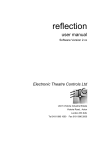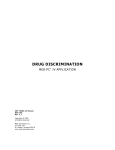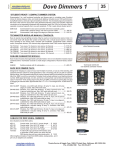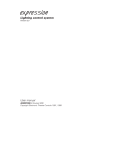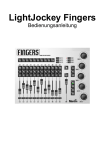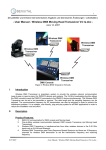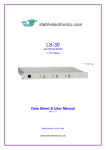Download reflection
Transcript
reflection user manual Software Version 2.xx Electronic Theatre Controls Ltd Unit 5 Victoria Industrial Estate Victoria Road , Acton London W3 6UU Tel 0181 896 1000 Fax 0181 896 2000 Reflection Users Guide Version 2.xx Electronic Theatre Controls Ltd table of contents Chapter 1 Introduction............... 1 Text conventions 1 Pile-on convention 1 Customer service 2 Chapter 2 Installation...................... 3 Installing your REFLECTION console 3 Connecting to dimmers 4 Installing analogue inputs 4 Installing expansion modules 5 Chapter 3 Tutorial 7 Switching on 7 Enabling dimmer output 8 Receiving input data 8 Recording backup states 8 Copying cues in output 8 Copying cues blind 9 Clearing submasters 9 Submaster pages Changing Submaster pages The freeze function 10 10 10 Input data failure 10 Momentary power failure 11 Using analogue inputs 11 Remote fader panels 11 Effects input 12 Reflection User Manual v2.xx.DOC TOC Reflection Users Guide Version 2.xx Electronic Theatre Controls Ltd In an emergency 12 Main console failure 12 Control room power failure 13 REFLECTION failure 14 Expanded systems (Master/Slave) Recording Submasters 14 14 Clearing Submasters 14 DMX failure 14 Other features Power-on alarm 15 15 System memory clear 15 DMX processing strategies 15 Byte-by Byte processing 15 Buffered DMX processing 16 Appendix B Jumper settings Console function jumpers 17 Expansion bus links 17 appendix C connector Schedules DMX Data Sockets 19 ANALOGUE INPUT CONNECTOR 19 EXPANSION PORT CONNECTOR 19 Reflection User Manual v2.xx.DOC TOC Reflection Users Guide Version 2.xx Electronic Theatre Controls Ltd chapter one introduction Reflexion is a digital lighting control device that provides seamless backup for lighting control consoles. It can also be used as an auxiliary lighting control console. In addition, Reflection supports analogue inputs that allow it to be configured as part of a house lighting control system./ When your main console is working normally, Reflection transmits DMX 512 output directly from the main console to the dimmers. If this flow of output data from console is interrupted for any reason, Reflection maintains the lighting configuration that was in effect when the main consoles output signal was interrupted and allows you to crossfade manually into backup looks. Reflection allows you to record upto 60 lighting looks over five pages, each page containing 12 memories. Once Reflection takes controls of the lights on stage, you can then execute manual crossfades between any of the recorded looks. This enables you to continue your show. When normal output is restored from the main console, you simply execute a manual crossfade to restore control to the main console. Reflection consoles support single DMX lines of 512 dimmers, To expand the system to accommodate other DMX Lines, Expansion Modules are available. These Expansion Modules are connected to one ‘main’ Reflection console and therefore all controls, faders, buttons etc are controlled from just one unit. Reflection can be expanded to accommodate 4 DMX Lines in total (one main console and three Expansion modules) Text conventions In this manual, console keys are indicated by square brackets, such as, [Freeze]. References to other sections of the manual as well as hints and tips are printed in italic, such as, Chapter 1, Introduction. Pile-on convention REFLECTION uses a pile-on convention rather than last-action convention to determine levels for channels that are acted on by several outputs. REFLECTION reads all output levels it receives for a specific dimmer and sets that channel to the highest of these. For example, assume a dimmer is included in one or more active submasters. If a dimmer is also included in the received DMX input, REFLECTION sets the channel at the greater of the two settings. Reflection User Manual v2.xx.DOC Page 1 Reflection Users Guide Version 2.xx Electronic Theatre Controls Ltd Customer service If you have problems with your console, please follow these steps: 1. Refer to this manual for operational instructions. 2. If you do not find the answer in the manual, call your local dealer or ETC Technical Services for customer service. Please have the following information available before you call: Console model and serial number (located on back panel) Software version (see sticker on rear of console) Options installed Demultiplexer type (if analogue dimmers) Dimmer type Main console type Reflection User Manual v2.xx.DOC Page 2 Reflection Users Guide Version 2.xx Electronic Theatre Controls Ltd chapter two installation This chapter includes set up instructions that you need to install REFLECTION and any optional accessories. This chapter includes the following installation procedures: Installing your REFLECTION console Installing analogue inputs Installing expansion modules Installing your REFLECTION console This section details the installation instructions for your REFLECTION, including connections to dimmers and control systems. 1. Place console on a hard, stable, flat surface with at least 150mm of space behind it for ventilation and cable clearance. Console should be at least 2m away from dimmers and high-current AC lines. Caution: Do not leave the console in a flightcase tray or on a soft surface. This will inhibit proper ventilation. 2. Verify that your dimmer connector pinout is correct. Pinouts for USITT DMX512 digital dimmer protocol is listed below. 3. Connect the male end of the short 5-pin XLR cable supplied with your REFLECTION console to the DMX512 dimmer data output of your main lighting control console. 4. Connect the female end of the same cable to the socket labelled Data in on REFLECTION's rear panel. 5. Connect the socket marked Data out to your DMX demultiplexer(s) or digital dimmers, using a standard DMX512 cable. 6. Set the power switch on the rear panel to the Off position. 7. Fit a suitable plug and connect the console power lead in a grounded 220-240 VAC outlet. For 120Vac operation, check with your authorised ETC service agent NOTE:Fuse replacement: Use only a 20mm 250mA anti-surge (T) fuse. Reflection User Manual v2.xx.DOC Page 3 Reflection Users Guide Version 2.xx Electronic Theatre Controls Ltd Connecting to Dimmers Dimmer data input and output conform to USITT DMX512 (1990) - the internationally accepted dimmer data protocol. To install dimmers, connect either direct to digital dimmers using the same standard, or to demultiplexers, such as the ETC CONNECTION Output Module. Note: When using DMX dimmers or demultiplexers, it is essential that the receiving unit is optically isolated from the data line. To be safe, always use ETC CONNECTION Output Modules, which offer full optical isolation from dimmer faults. Connector Type: XLR 5-pin chassis female (DMX Out) Pinout 1 Common 2 Data (-) (DMX512) 3 Data (+) (DMX512) 4 Not used 5 Not used Cable Type Shielded twisted pair approved for RS422/485, eg Belden 9841, Alpha 5271 should be used for runs of up to 1000 metres. Installing analogue inputs The analogue input option allows you to connect up to 12 standard 0 to +10Vdc analogue control signals in parallel with REFLECTION's submaster faders, for use with remote panels for such purposes as houselight, worklight and rehearsal lighting control. This feature may also be used to pile on the output from a chase unit to REFLECTION's submaster faders. Note: REFLECTION analogue inputs are not suitable for negative (Strand) control signals. Connector Subminiature DB15 male Pinout Pins 1-12 Pin 13-15 channel 1-12 common return Note that, for reasons of safety and security, REFLECTION is intended for use with selfpowered external analogue sources. Passive fader panels will need to be supplied with their own power supply units. If in doubt, consult your authorised ETC service agent. Reflection User Manual v2.xx.DOC Page 4 Reflection Users Guide Version 2.xx Electronic Theatre Controls Ltd Installing expansion modules An expanded REFLECTION system is operated and behaves exactly like a single REFLECTION console, but can backup up to four DMX512 data streams. The Master console's switches and faders control not only its own operation but also all operations of the 3 Slave units. Full REFLECTION consoles, as well as purpose built REFLECTION CPU Modules (which have no Control Panel), can be set for operation as Slaves. If a full REFLECTION console has its dipswitches set for Slave function then its Control panel is disabled; all control is made via the Master's Control panel. Its LEDs do however continue to indicate its status. Automatic functions and alarms operate system-wide; eg if any DMX input is lost then the whole system (Master & Slaves) will automatically enter Input Freeze Mode. Master and slave units communicate via a three wire cable using I2C communications protocol. Pin configurations and wire specifications are given below To install Slave units follow these steps: 1. Ensure that the Master REFLECTION console and the Slave consoles are fitted with the same software version. (Note: Master/Slave operation requires V2.06 or later) 2. Open the slave unit by removing the four securing screws and lifting the lid. 3. Remove the two jumpers that are fitted to LK2 & LK3. 4. Fit one or both jumpers to positions C & D following the chart on page 5. Note: Ensure that each slave unit to be used in the system is set with its own unique address. Jumper Master Unit Slave #1 Unit Slave #2 Unit Slave #3 Unit C O/C S/C O/C S/C D O/C O/C S/C S/C Affix a label on the rear of the unit identifying what slave number the unit is set for. This can be useful in situations where a number of units could be interchanged Replace the lid and securing screws. Prepare and fit the Expansion cable to the Master Unit and Slave unit(s) (see below) Plug one end of the short DMX cable (supplied) in to the Data in socket on the rear panel of the slave unit and the other end to its DMX source. This may be a second output on the same console or from another Control desk. Connect the Dimmer DMX line to the socket Data out on the rear panel. The other end of which then connects to either a DMX demultiplexer or Digital Dimmer. Reflection User Manual v2.xx.DOC Page 5 Reflection Users Guide Version 2.xx Electronic Theatre Controls Ltd Expansion port cable connector D-Type 9 pin free plug. Pinout pin 1= 0V (common) pin 2= bi-directional open drain DATA bus. pin 3= open drain CLOCK bus. pins 4-9= n/c The cable is wired one-to-one to each connector (Max 4) and should be as short as possible, so if you are only using 1 Slave unit then just make the cable with two connectors. For two slave units, use three connectors 'daisy-chained', for three slave units, use four connectors 'daisy-chained'. IE: Master Slave 1 Slave 2 Slave 3 Pin 1 Pin 1 Pin 1 Pin 1 Pin 2 Pin 2 Pin 2 Pin 2 Pin 3 Pin 3 Pin 3 Pin 3 Cable requirements: The cable should be a two core twisted pair with overall braid or foil screen and drain wire. Example cable :RS 360-649, Alpha 2461, Belden 8451. The maximum length from Master unit to furthest Slave unit is limited by the TOTAL capacitance of the cable used, which must not exceed 300pF. Example: Alpha 2461, rated 111pF/m.: / Max length = 300pF 111pF/m = 2.7 metres In many situations standard DMX cable (not microphone cable) may be used for interconnecting master and slave units with a maximum length of 1.8 metres . Check the Data Sheet for your particular cable. Reflection User Manual v2.xx.DOC Page 6 Reflection Users Guide Version 2.xx Electronic Theatre Controls Ltd chapter three Tutorial With the REFLECTION console set up as described in the previous chapter, you are now ready to learn how to use it. This chapter includes sections on the following topics: Switching on your REFLECTION console Recording backup states Submaster pages The freeze function Using analogue inputs In an emergency... Expanded systems (Master-Slave) operation Other features We strongly suggest that you work through all of this section of the manual with the equipment set up and running, before using REFLECTION on a show. Switching on your REFLECTION console This section details the initialisation procedure each time you switch on your REFLECTION console. Switching on At switch-on, REFLECTION's faders should normally be set as follows: input fader up all 12 submaster faders down Switch on REFLECTION using the power switch on the rear panel. After two seconds (REFLECTION is carrying out its initialisation procedures) you will see/hear the following: An intermittent tone sounds The red freeze Led flashes The green input data LED lights if good data is being received One of the green page LEDs lights (corresponding with the last active page prior to the previous shutdown), as well as the LEDs of any submasters recorded in the current page The tone and flashing freeze LED indicate that REFLECTION is on, but is as yet not transmitting any dimmer data. This is important in various emergency situations, and will be covered in detail in the section on the freeze function below. Reflection User Manual v2.xx.DOC Page 7 Reflection Users Guide Version 2.xx Electronic Theatre Controls Ltd Enabling dimmer output Normally, you will simply press [freeze] to release the freeze function and allow REFLECTION to start transmitting dimmer data. If your main console is off, disconnected or not transmitting dimmer data, you will now hear a higher frequency tone, telling you that REFLECTION is not receiving valid dimmer data. This tone will continue for ten seconds, then stop. When no data is received on REFLECTION's data input, the input data LED on the front panel is off. REFLECTION may now be used as a stand-alone console. If input data is subsequently received, the green input data LED will switch on and the input data will be used (see next section). Receiving input data REFLECTION receives dimmer data from the output of any suitable lighting control console, and immediately passes it to the dimmers. The input fader proportionally controls the level of the input from the main console, and should therefore normally be kept at its highest position (10), so that main console levels will be transmitted directly to the dimmers, with no change in level. You can fade down the current output of the main console at any time by lowering the input fader below 10. Please note that REFLECTION's submaster faders may be combined with the input state at any time, simply by raising the appropriate fader(s) above zero. When the same dimmer is present in more than one fader, the highest level will be passed to the dimmers Recording backup states With the main console transmitting data to the dimmers via REFLECTION, you are now ready to start copying cues into REFLECTION's submaster faders. Copying cues in output 1. Set up and output the state you want to copy on your main console. 2. Check that REFLECTION is in the page you want to use. If it isn't, press the appropriate page button to select it and switch on the correct page LED. 3. Press [record]. The red record LED lights. 4. Press the submaster bumpswitch for the desired submaster. The current state being received from the main console is copied into the desired submaster in the current page. If the current received state is a blackout, the submaster will not be recorded, and any previous levels in the submaster will be cleared. Note: If you press [record] by mistake, a second press cancels the record operation. For Record Lockout, See Jumper Settings in the appendix section in this manual. Reflection User Manual v2.xx.DOC Page 8 Reflection Users Guide Version 2.xx Electronic Theatre Controls Ltd Copying cues blind You can get ahead by copying a batch of cues into REFLECTION, even during the show. 1. Pick a quiet period between cues to do this! Make a note of the current cue being output by the main console, and check that any REFLECTION submasters to be recorded are at zero. 2. Press [freeze]. This causes the current state being received from the main console to be frozen in REFLECTION's output. The input freeze LED flashes red. 3. Now send the first state to be copied from the main console. Because REFLECTION is in freeze mode, this will not affect the output to the dimmers. 4. Press [record], followed by the bumpswitch of the desired submaster. The new input state is now copied into the chosen submaster. 5. Repeat this procedure for as many states as you wish to copy. You may change pages without affecting output. 6. Resend the original state from the main console, and press [freeze] again. This unfreezes REFLECTION, without affecting output, and with the new backup states safely recorded. Clearing submasters To clear individual recorded submasters all that is required is to record a Blackout Cue in to a fader 1. Send a blackout from the main console (using output or blind techniques described above) 2. Select the page required by pressing the appropriate page switch 3. Press [record] followed by the bumpswitch of the submaster to be cleared 4. The submaster is now erased. Note: A submaster which has been cleared may not be restored, except by recopying its contents from the main console. To clear all recorded submasters on all pages: 1. Turn REFLECTION off. 2. Hold down bumpswitches 7-8-9 and turn REFLECTION on, keeping the buttons pressed. The unit will flash all LEDs on and then return to a fresh state with all faders empty. Reflection User Manual v2.xx.DOC Page 9 Reflection Users Guide Version 2.xx Electronic Theatre Controls Ltd Submaster pages Although REFLECTION has only 12 submaster faders, its power is greatly increased by having five pages of submaster memory. This means that for each of five pages, you have a set of twelve submaster memories - 60 in all. Pressing one of the page switches selects that page to be active. The green LED next to the appropriate page switch is lit. If any submasters on the current page have already been recorded, their LEDs will also light, showing you which submasters are already in use. Changing submaster pages You can change the active submaster page at any time by pressing the appropriate button - page 1 through page 5. When you do this: The new page LED lights, and the old one goes out. The green submaster LEDs light for any submasters in the new page which are already recorded. If you change page while a submaster from the current page is above zero, the following points should be noted: The contents of the active submaster are not affected by the page change. The green LEDs of any active submasters containing states from other pages flash to indicate that they are not part of the current page. The green page LED for the newly loaded page flashes to indicate that the page change operation is not complete. In this situation, the active submaster(s) from previous pages may still be manually faded up or down, but when they reach zero, the old state is lost, and the state from the new page (if any) is automatically loaded. When all states from previous pages have been cleared in this way, the page LED stops flashing, to indicate that the page change operation is complete. In this way, it is possible to have a number of submasters from different pages active at the same time, and of course it means that page changing is completely safe, since active submasters are not affected until they reach zero. The freeze function We saw in the last section how the freeze function can be used to freeze REFLECTION's output in order to copy states blind from the main console. This was a voluntary use of freeze. Strictly speaking, pressing [freeze] during normal operation locks the current input state into the input master fader. REFLECTION continues to use the frozen state to send to the dimmers, instead of what is actually being received from the main console. But freeze also has automatic functions which should be understood. The following is a description of the two automatic freeze functions. Input data failure If input data fails, REFLECTION automatically goes into freeze mode. When this happens: A tone sounds intermittently for 10 seconds The input data LED switches off Reflection User Manual v2.xx.DOC Page 10 Reflection Users Guide Version 2.xx Electronic Theatre Controls Ltd The last valid data packet received from the main console is frozen, and may be controlled by the input master fader. Momentary power failure It may happen that power is lost in the control room, causing the main console to reset when power is restored. This is a potentially dangerous situation: normally, when control room power is lost, the DMX receivers at the dimmers will maintain the last good data, until see DMX restored. The problem is that most lighting consoles reset to a 'clean' state where they are sending a stream of zero levels. This means that, although all may seem to be well from the time power is lost up to the time when the console is initialising, when initialisation is complete, the lights may go out! REFLECTION solves this problem by going into freeze mode when either: Power is applied, or Input data fails. If power is lost in the control room, taking out REFLECTION as well as the main console, when it is restored, REFLECTION transmits no DMX data until freeze is released. This gives you time to set up the main console into the correct output state before pressing [freeze] to continue the show. If the problem was a main console failure or loss of power to the main console only, REFLECTION detects bad or missing input data and automatically freezes the input master with the last good data received. If the main console recovers from its problem, it need only be set to the cue being sent at the time of the failure, at which time pressing [freeze] will resume normal operation. Using analogue inputs The analogue input connector on the rear panel of the REFLECTION console enables any standard self-powered +10Vdc signal to be used to drive REFLECTIONs submasters. The analogue inputs should be seen as parallel faders to the submasters, and work on a highest takes precedence basis between inputs 1-12 and submasters 1-12 respectively. See Chapter 2 - Installation for information on connecting REFLECTION's analogue inputs. The analogue input option may be used in a number of ways, some of which are described below. Remote fader panels Fader panels with between one and twelve faders may be used to control REFLECTION's submasters for a number of uses: Houselight control Houselight dimmers are nowadays frequently integrated into the production lighting dimmer racks, and controlled using a separate control system. It is certainly true that, for safety reasons, house lighting control circuits should be independent of the main console. Using REFLECTION, both options are available. Houselight dimmers can be controlled by the main console when required for effects, and submasters (for example groups 1012) can be assigned on all five pages of REFLECTION's memory. If three-fader panels are wired to REFLECTION and located in the auditorium or prompt corner, the houselight states can readily be controlled from any position. Rehearsal lighting Reflection User Manual v2.xx.DOC Page 11 Reflection Users Guide Version 2.xx Electronic Theatre Controls Ltd Using a similar principle, a rehearsal lighting state can be set up using the main console, copied into a REFLECTION submaster, and controlled from any point in the building. Thus, without having the main console on, or an operator standing by, the rehearsal lights can be faded up as required by stage management. News/current affairs studios Using any DMX source, a number of states may be set up in a small studio, and controlled via faders or by remotely controlled ramp circuits. This has applications for remote regional studios, interview studios and the like. Effects input Any effects generator with industry standard +10Vdc analogue outputs may be connected to REFLECTION's analogue inputs, to augment the effects capability of the main console. In an emergency REFLECTION automatically protects against a number of possible fault conditions, listed below. Remember that, once the main console dies, you have no way of programming new memories into REFLECTION, so: always be sure you have copied enough backup states into REFLECTION before the show! We recommend that you copy all your cues (if less than 60) into REFLECTION for every show. Then, on your plot or script, make a note of the REFLECTION submaster and page to correspond with cue. Below, we describe the three main control room faults which can (very rarely) arise during a show, and how REFLECTION can get you out of trouble. Please become thoroughly familiar with these procedures, so that you will be as ready as REFLECTION to do the right thing in a real emergency! Main console failure In rare circumstances the main console might crash or lose power or memory. Most fault conditions involve loss or corruption of dimmer data output. REFLECTION automatically detects such a fault in its data input stages and disregards any signal which does not conform to DMX512. At the same time it safeguards the last good data received, which is, as always, mastered by the input master fader. REFLECTION warns you about the problem in the following ways: audible warning - 20 beeps at 2Hz freeze LED flashes red input data LED goes out This is what you do: 1. Don't panic! REFLECTION is still sending the last good state received from the main console to the dimmers. Nothing should have changed on stage. 2. See if you can revive the main console in time for the next cue. If you can, skip to step 6. 3. Check your cue sheet for the submaster and page required to back up the next cue, and select the appropriate page on REFLECTION, if it is not already selected. 4. When the time comes for the next cue, execute a manual crossfade, fading the appropriate submaster up and the input master fader down. Reflection User Manual v2.xx.DOC Page 12 Reflection Users Guide Version 2.xx Electronic Theatre Controls Ltd 5. Continue the show, carrying out page changes as required (see above) and manual crossfades between submasters. 6. If the main console can be revived: 7. Switch on the main console and wait for it to initialise. Check carefully that REFLECTION's green input data LED is on. Do not go any further until REFLECTION indicates that good data is being received. 8. When REFLECTION's input data LED is on, you can send the current cue from your main console. Nothing happens yet, as REFLECTION's input is still frozen. 9. When you are sure that you are sending the right output from the main console, check that the input master fader is at zero, and press [freeze]. The freeze LED turns green. 10.Carry out a manual crossfade between any active REFLECTION submasters and the input master. When the input master is at 10 and the submasters are out you can continue the show on the main console as before. Control room power failure It's possible to lose power in the control room, without the dimmers being affected. In this case, the demultiplexers at the dimmers will keep sending the last data received from the console before communications were lost, so lights don't go out. Note: The above is true of ETC CONNECTION Output Modules and other receivers following the guidelines of USITT DMX512. We cannot guarantee that such devices from all manufacturers will include this feature. Eventually, we assume that power will be restored. Be aware that some power outs are extremely brief, but they may be long enough to cause electronic equipment to reset. When power is restored, REFLECTION will initialise as described in Switching on above. Until you press [freeze], REFLECTION sends nothing to the dimmers This is what you do: 1. Don't panic! The demultiplexers are still sending the last good state received from the main console to the dimmers. Nothing should have changed on stage. 2. Switch on the main console and wait for it to initialise. Check carefully that REFLECTION's green input data LED is on. Do not go any further until REFLECTION indicates that good data is being received. 3. When REFLECTION's input data LED is on, you can send the current cue from your main console. Nothing happens yet, as REFLECTION's input is still frozen. 4. When you are sure that you are sending the same output from the main console as that being output by the dimmers, check that the input master fader is at 10, and press [freeze]. The freeze LED turns green and the output from the main console is passed directly through to the dimmers. If the state of the dimmers is the same as that being sent by the main console, there will be no change in dimmer levels. 5. Continue the show on the main console as before. Reflection User Manual v2.xx.DOC Page 13 Reflection Users Guide Version 2.xx Electronic Theatre Controls Ltd REFLECTION failure Well, it could happen! If REFLECTION were to fail, we would expect that the dimmers demultiplexer would hold up the last good data received, therefore not affecting dimmer levels. This is what you do: 1. Remove the XLR male and female connectors from REFLECTION's rear panel, and join them together positively (to avoid making and breaking contact). 2. The demultiplexers are now receiving dimmer data direct from the main console. Continue the show as normal and call your ETC service agent. Expanded systems (Master-Slave) operation An expanded REFLECTION system is operated and behaves exactly like a single REFLECTION console, but can backup up to four DMX512 data streams. The Master console's switches and faders control not only control its own operation but also all operations of upto 3 Slave units. For installation of Slave units on to a Master, please refer to Chapter 2, Installing Expansion Modules. Full REFLECTION consoles, as well as purpose built REFLECTION CPU Modules (which have no Control Panel), can be set for operation as Slaves. If a full REFLECTION console has its dipswitches set for Slave operation, then its Control panel is disabled; all control is made via the Master's Control panel. The full REFLECTION unit operating as a slave will continue to indicate its status via its own LEDs. Recording Submasters Recording your safety looks in to a REFLECTION system is achieved in the same way as a single REFLECTION. First setup your total 'look' on the main console, select the page that you want the look to be saved on to and press [Record] [Sub-Bump]. The Master and Slave units will store in to their own memory the correct levels for each DMX line. The Master unit will indicate which submasters have levels programmed in either the Master or Slave units. Clearing Submasters Clearing submasters is again performed in exactly the same way by sending all zero levels from the control desk. It is worth remembering that if any of the DMX lines has nonzero level set, eg a pre-heat level, then the system will assume that you wish to record it as a 'look' and not extinguish the Submaster LED. To clear all of the submasters across the system, first power on the Slave units. Then, while holding down bump-buttons 7-8-9 on the Master, turn the Master unit on. The REFLECTION will then give a short bleep while it performs the clear on all of the units after which normal operation will resume. DMX Failure Automatic functions and alarms operate system-wide; eg if any DMX input is lost then the whole system (Master & Slaves) will automatically enter Input Freeze Mode. For example, a system that comprises of one Master REFLECTION console and two Slaves is backing up a control desk with three DMX outputs. Should the main desk fail on one DMX line, all three REFLECTION units will go in to freeze mode (sounding the beeper and red LED), maintaining the last 'look' for each DMX output. The faders on the Master Reflection User Manual v2.xx.DOC Page 14 Reflection Users Guide Version 2.xx Electronic Theatre Controls Ltd unit can now be used to bring in the pre-stored looks for each DMX line simultaneously. Once control has been passed safely to the REFLECTION system, the cause of the fault can now be traced. Each of the Slave units has its own Input Data LED which in the example above, will be extinguished on the unit with the missing DMX source. Once the fault has been corrected, cross-fading back to the main console is the same as for a single REFLECTION unit. Should a Slave unit be unable to communicate with its Master, it will beep at short intervals warning you that something is wrong. If his happens, check that the Expansion port cable is plugged in and that the Master unit is turned on. If you are unable to make the Slave unit operate with the rest of the system, then remove the Expansion port cable from the faulty Slave unit and by-pass the DMX by connecting the DMX-In lead to the DMX-Out lead. This will at least allow you to continue with a part protective system. OTHER FEATURES Power-on Alarm After REFLECTION is turned on it will not transmit DMX until the operator has pressed the Input Freeze button. To remind the operator that its output DMX is still disabled REFLECTION sounds its alarm at 1Hz. By popular request we have made the power-on alarm optional. It can be disabled by placing a shorting clip on Jumper A. Note: this does not disable the Loss-of-DMX alarm (at 2Hz) which REFLECTION gives when it has gone into Automatic Input Freeze mode, having detected that the incoming DMX stream has failed. System Memory Clear Clear System Memory operation is initiated in the same way as for other ETC control systems, press and hold down bumpbuttons 7, 8 & 9 and apply power. When you hear the first alarm the operation is complete and you may release the bumpbuttons; all stored states will have been cleared and the system is ready for operation. This is, of course, the simplest way to clear out all stored states prior to storing new backup states for a different show. In the case of an expanded REFLECTION system, with a Master and one or more Slaves, you should connect their Expansion ports, apply power to the Slaves first, hold down the Master's 7, 8 & 9 bumpbuttons and finally apply power. The Master will pass the Clear System Memory command to each of its Slaves, so that memory in all units is cleared simultaneously. DMX PROCESSING STRATEGIES With version 2.06 software fitted, it is now possible to select the method by which DMX is processed. Two alternative modes are provided, Byte-by-Byte or Buffered. The unit is configured for Buffered Mode as a default as this will allow the unit to operate with all DMX type consoles. If you experience problems with a particular DMX source, in which case you should switch to Byte-by-Byte processing. Byte-by-Byte processing: When a byte arrives in the processor's input SIO data register it is immediately passed to the hardware calculator. 6 æ s later the processor gathers the calculated result and immediately passes it to the output SIO data register. The net effect is that one byte is transmitted for every byte received, which in turn means that the output DMX stream is Reflection User Manual v2.xx.DOC Page 15 Reflection Users Guide Version 2.xx Electronic Theatre Controls Ltd fully synchronised with the input DMX stream. The total system throughput delay will be between 44us and 88us (between one and two byte times). This method deals successfully with all DMX sources and receivers in production today. However, to be able to deal with ever increasing DMX speeds and varieties that are permissible under the DMX512:1990 standard we have included a second handling routine for incoming DMX, referred to as Buffered DMX throughput. Buffered DMX processing: In this mode, incoming DMX data bytes are received under the highest priority interrupt and stored in a buffer in the battery-backed SRAM. The microprocessor also deals with interrupts (at the second priority level) from the output SIO whenever it has completed transmission of the latest output byte. At each output interrupt the microprocessor fetches the next byte in sequence from the input data buffer, passes it through the hardware calculator subsystem and finally sends the result to the output SIO. This therefore separates the timing of the incoming DMX and the outgoing DMX and allows the output DMX stream to continue smoothly even if the input DMX exhibits intermittent illegal timing or framing errors. Reflection User Manual v2.xx.DOC Page 16 Reflection Users Guide Version 2.xx Electronic Theatre Controls Ltd appendix B jumper settings Console Function Jumpers There are 5 main jumpers located in the centre of the processor PCB. These are identified as A through E. The following table shows the options that can be selected from the jumpers. Note: These jumper settings are valid for software version 2.06 only. Jumper Open circuit Short circuit A Power-on beep Enabled Power-on beep Disabled B Byte-by-Byte DMX Buffered DMX throughput C D CPU Address in CPU Address in Expanded systems only Expanded systems only Record Enable Record Disable (RAM Write Protect) E Jumper settings shown underlined are factory defaults Jumper A when fitted disables the Power-On alarm. Jumper B when fitted enables Buffered DMX processing. See chapter 3, DMX Processing Strategies for a full explanation on the use of this jumper. Jumper C & D set the unit to act as a Slave (see below) Jumper E when fitted disables the record function. EXPANSION (I2C) BUS LINKS: To use REFLECTION in a Master/Slave arrangement you must define a unique address for each Slave unit that is connected to the Master via the Expansion Bus. When setting jumpers and links for an expanded system there are three points to note: 1. NO MORE THAN THREE SLAVE UNITS CAN BE CONNECTED TO A MASTER UNIT. 2. ENSURE THAT EACH SLAVE UNIT IS SET WITH A UNIQUE ADDRESS. 3. ENSURE THAT LK2 & LK3 ARE REMOVED FROM EACH SLAVE UNIT. The Master unit will require LK2 & LK3 to be fitted. No address links are used in a Master unit, ie it's address is 00h. Each Slave unit will need links to be set on jumpers C & D as shown in the table below. Use one or both of the shorting links which you have removed from LK2 & LK3. Note that jumpers C & D correspond to D0 & D1 of the Slave address, expressed in binary notation. Reflection User Manual v2.xx.DOC Page 17 Reflection Users Guide Version 2.xx Electronic Theatre Controls Ltd Jumpers Master Unit Slave #1 Unit Slave #2 Unit Slave #3 Unit C O/C S/C O/C S/C D O/C O/C S/C S/C LK2 Fitted Not Fitted Not Fitted Not Fitted LK3 Fitted Not Fitted Not Fitted Not Fitted LK2 & LK3 connect 1.8k pull up resistors (R3 & R4) to the I2C Bus. There must only be one pair of pullups on the I2C bus, so LK2 & LK3 must only be fitted in the Master Unit. Early revisions of the CPU PCB (Revs 1 to 3) have 1.8k pull up resistors (R3 & R4) which are hardwired onto the bus. To configure a Rev 3 or earlier PCB for use as a Slave unit it is necessary to cut those two resistors from the PCB. Reflection User Manual v2.xx.DOC Page 18 Reflection Users Guide Version 2.xx Electronic Theatre Controls Ltd appendix c connector Schedules DMX Data Sockets DATA IN - 5 Pin XLR Plug DATA OUT - 5 Pin XLR Socket Pinouts pin 1 0V reference pin 2 RS485 DATA- pin 3 RS485 DATA+ pin 4 reserved pin 5 reserved ANALOGUE INPUT CONNECTOR D-Type 15 pin Chassis Plug pins 1 to 12 = Inputs 1 to 12 pins 13,14 & 15 = 0V (common) Input voltage range: 0v (off) to +10v (full) Recommended Cable type : Multi-core cable with overall screen EXPANSION PORT CONNECTOR D-Type 9 pin Chassis Socket. pin 1= 0V (common) pin 2= bi-directional open drain DATA bus. pin 3= open drain CLOCK bus. pins 4 to 9= n/c As both data and clock lines are bi-directional, the cable must be wired pin to pin from the Master connector to each Slave connector. Cable requirements: The cable should be a two core twisted pair with overall braid or foil screen and drain wire. Example cable :RS 360-649, Alpha 2461, Belden 8451. The maximum length from Master unit to furthest Slave unit is limited by the TOTAL capacitance of the cable used, which must not exceed 300pF. Example: Alpha 2461, rated 111pF/m.: Max length = Reflection User Manual v2.xx.DOC / 300pF 111pF/m = 2.7 metres Page 19 Reflection Users Guide Version 2.xx Electronic Theatre Controls Ltd In many situations standard DMX cable may be used for interconnecting master and slave units with a maximum length of 1.8 metres. Check the Data Sheet for your particular cable. Reflection User Manual v2.xx.DOC Page 20























